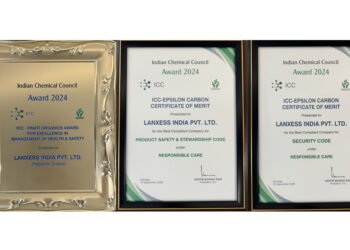- Black pigment from LANXESS for coloring recyclable plastic packaging
- Enables reflectivity that is up to 20 percent better near-infrared detection in automated sorting plants
- Reduced magnetic properties prevent false alarms
New Delhi, October 19, 2021 – Consumers, environmental organizations, politicians and industry are increasingly taking action to reduce microplastics. Reusing plastic waste as a raw material also contributes to this, but requires that the different plastics be separated according to type first. “With our latest black pigment, we can help to increase the recycling rate for plastic packaging, which is still far too low around the world,” says Stefano Bartolucci, Global Market Segment Manager for Plastics in the Inorganic Pigments (IPG) business unit at LANXESS. With Bayferrox 303 T, the specialty chemicals company has developed a black pigment for coloring black plastic that reflects 20 percent of near-infrared radiation (NIR). This enables plastics to be identified efficiently and cost-effectively with the aid of NIR detectors like those used for sorting waste. “Plastic packaging colored with carbon black, on the other hand, as is used in large part today, does not reflect any radiation and therefore cannot be detected in sorting plants,” says Bartolucci.
Near-infrared detection of composite materials in automated sorting plants
Properly separating waste and producing recycling materials that are separated according to type is expensive. It is difficulties in sorting waste that are currently causing the recycling rate of plastic to remain far too low worldwide. Composite materials and black plastic are particularly difficult to sort, as are foils that are glued together or small transparent trays made from PET. The LANXESS pigment Bayferrox 303 T can make a decisive contribution to recycling black plastic packaging.
In automated recycling plants, near-infrared detection (NIR spectroscopy) is used to quickly sort plastic waste into different types. To this end, infrared cameras are installed above the conveyor belts in most cases. However, black plastic packaging such as foils cannot be identified correctly by the optical sensors due to its color and consequently cannot be sorted. Unlike the carbon black pigments often used in the plastics industry, Bayferrox 303 T reflects infrared radiation, thus allowing identification with the aid of NIR detectors. As a result, black plastic items such as packaging films or trays can be better identified with the iron-manganese mixed oxide and sent for recycling.
Nowadays, three types of pigments are principally used to color plastic packaging. In terms of quantity, carbon black is the pigment most frequently used for black packaging materials, as it is available at low cost on the market and exhibits high color strength. But it does not reflect infrared radiation and items made with it remain virtually invisible in sorting plants. Thus large quantities of plastic packaging cannot be sent for recycling.
Complex inorganic colored pigments (CICPs) and manganese ferrites, of which the latter are far more cost-effective, are high-quality alternatives to carbon black thanks to their property profiles – because they reflect infrared light. The iron-manganese mixed oxide Bayferrox 303 T from LANXESS also offers color strength that is 20 percent higher than comparable pigments.
Reduced magnetic properties prevent false alarms
The reduced magnetic properties of Bayferrox 303T make it ideal for coloring plastic packaging. Magnetizable pigments can trigger false alarms during quality control processes in the food industry, for example, disrupting production as a result. After all, metal detectors cannot distinguish between pigments and pieces of metal in an edible item. This is why metal contaminants must be avoided in both the masterbatch and the packaging.
“Thanks to a special manufacturing process, we have succeeded in synthesizing a pigment with an extremely low magnetic value. If you compare our Bayferrox 303 T with standard manganese ferrites, the magnetism has been reduced by more than 50 percent,” says Bartolucci. “With our black pigment, false alarms in production can be avoided and a higher degree of process reliability can be achieved because there are fewer interruptions,” he adds.
You can find more detailed information about LANXESS products for coloring plastics on the website at www.bayferrox.com.

















